Choosing a Gaming CPU at 1440p: Adding in Haswell
by Ian Cutress on June 4, 2013 10:00 AM ESTCPU Benchmarks
Point Calculations - 3D Movement Algorithm Test
The algorithms in 3DPM employ both uniform random number generation or normal distribution random number generation, and vary in amounts of trigonometric operations, conditional statements, generation and rejection, fused operations, etc. The benchmark runs through six algorithms for a specified number of particles and steps, and calculates the speed of each algorithm, then sums them all for a final score. This is an example of a real world situation that a computational scientist may find themselves in, rather than a pure synthetic benchmark. The benchmark is also parallel between particles simulated, and we test the single threaded performance as well as the multi-threaded performance.
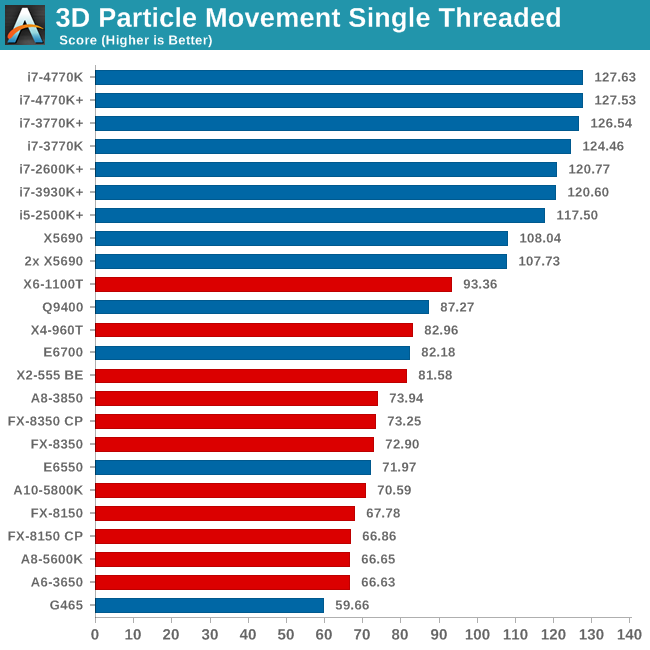
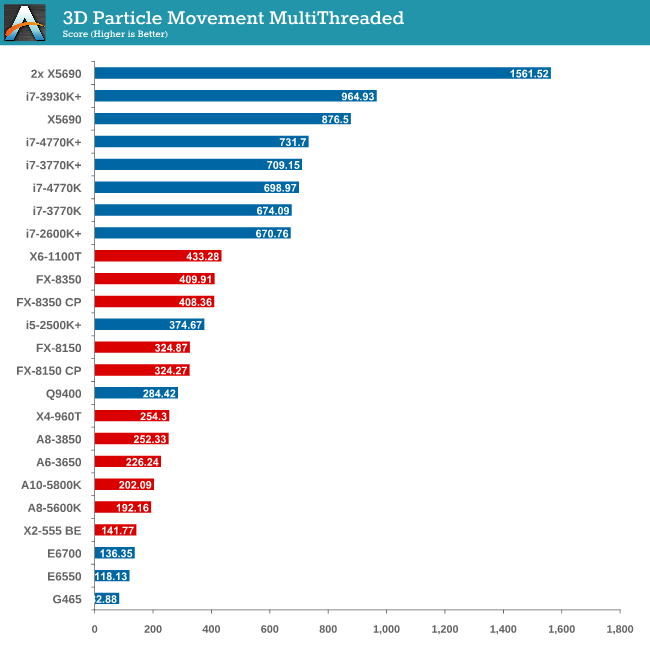
As mentioned in previous reviews, this benchmark is written how most people would tackle the situation – using floating point numbers. This is also where Intel excels, compared to AMD’s decision to move more towards INT ops (such as hashing), which is typically linked to optimized code or normal OS behavior.
The 4770K comes in top in single threaded performance, showcasing the IPC gains of the new architecture. This is also shown in multithreaded tests with MCT both off and on.
Compression - WinRAR x64 3.93 + WinRAR 4.2
With 64-bit WinRAR, we compress the set of files used in our motherboard USB speed tests. WinRAR x64 3.93 attempts to use multithreading when possible and provides a good test for when a system has variable threaded load. WinRAR 4.2 does this a lot better! If a system has multiple speeds to invoke at different loading, the switching between those speeds will determine how well the system will do.
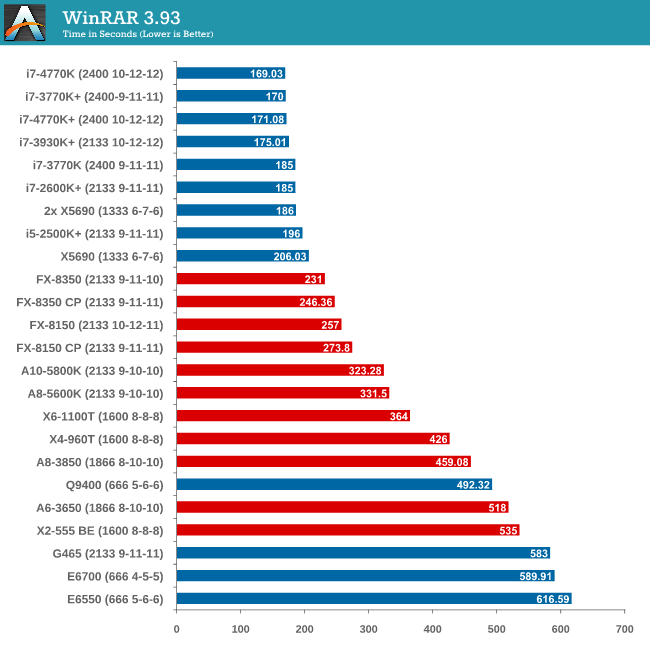
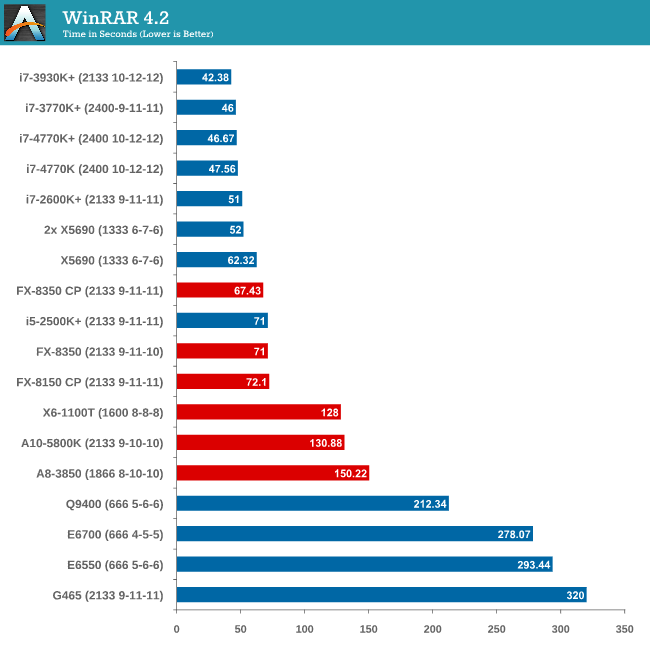
Due to the late inclusion of 4.2, our results list for it is a little smaller than I would have hoped. But it is interesting to note that with the Core Parking updates, an FX-8350 overtakes an i5-2500K with MCT.
Image Manipulation - FastStone Image Viewer 4.2
FastStone Image Viewer is a free piece of software I have been using for quite a few years now. It allows quick viewing of flat images, as well as resizing, changing color depth, adding simple text or simple filters. It also has a bulk image conversion tool, which we use here. The software currently operates only in single-thread mode, which should change in later versions of the software. For this test, we convert a series of 170 files, of various resolutions, dimensions and types (of a total size of 163MB), all to the .gif format of 640x480 dimensions.
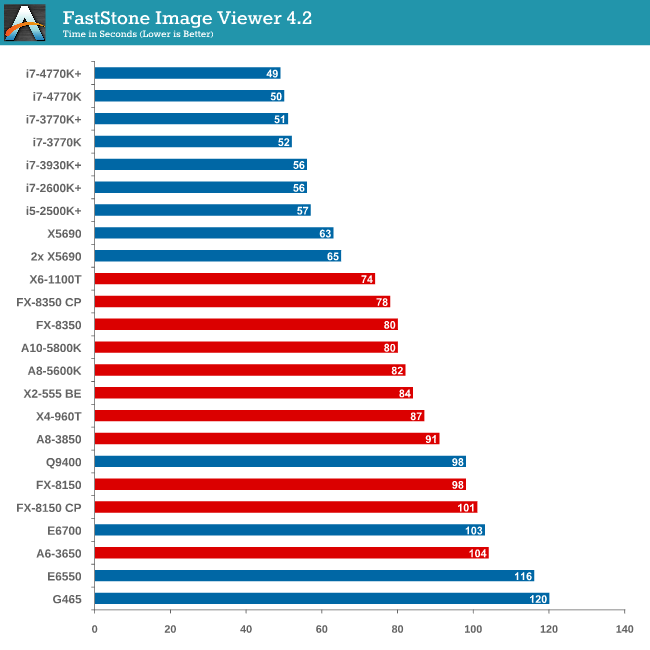
In terms of pure single thread speed, it is worth noting the X6-1100T is leading the AMD pack, and the 4770K takes the top spot. .
Video Conversion - Xilisoft Video Converter 7
With XVC, users can convert any type of normal video to any compatible format for smartphones, tablets and other devices. By default, it uses all available threads on the system, and in the presence of appropriate graphics cards, can utilize CUDA for NVIDIA GPUs as well as AMD WinAPP for AMD GPUs. For this test, we use a set of 33 HD videos, each lasting 30 seconds, and convert them from 1080p to an iPod H.264 video format using just the CPU. The time taken to convert these videos gives us our result.
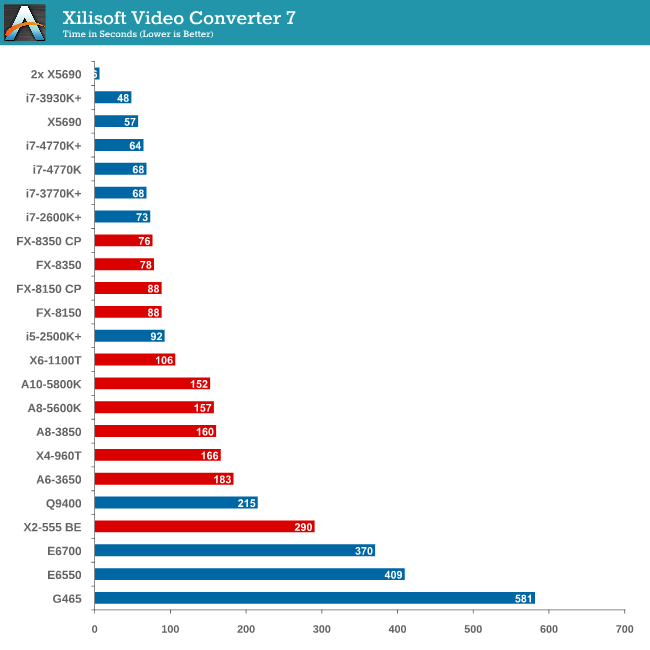
XVC is a little odd in how it arranges its multicore processing. For our set of 33 videos, it will arrange them in batches of threads – so if we take the 8 thread FX-8350, it will arrange the videos into 4 batches of 8, and then a fifth batch of one. That final batch will only have one thread assigned to it (!), and will not get a full 8 threads worth of power. This is also why the 2x X5690 finishes in 6 seconds but the normal X5690 takes longer – you would expect a halving of time moving to two CPUs but XVC arranges the batches such that there is always one at the end that only gets a single thread.
Rendering – PovRay 3.7
The Persistence of Vision RayTracer, or PovRay, is a freeware package for as the name suggests, ray tracing. It is a pure renderer, rather than modeling software, but the latest beta version contains a handy benchmark for stressing all processing threads on a platform. We have been using this test in motherboard reviews to test memory stability at various CPU speeds to good effect – if it passes the test, the IMC in the CPU is stable for a given CPU speed. As a CPU test, it runs for approximately 2-3 minutes on high end platforms.
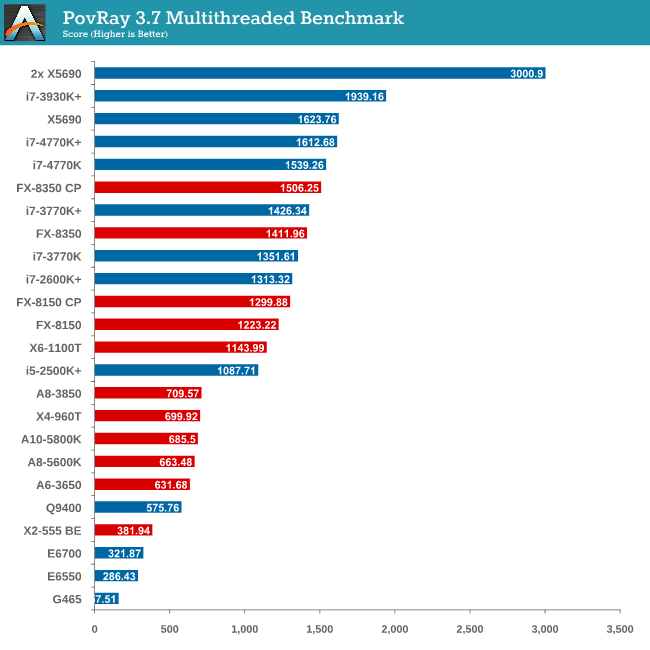
The SMP engine in PovRay is not perfect, though scaling up in CPUs gives almost a 2x effect. The results from this test are great – here we see an FX-8350 CPU below an i7-3770K (with MCT), until the Core Parking updates are applied, meaning the FX-8350 performs better! The 4770K also has a chance to flex its compute muscles, performing almost as well as the 8-core Westmere CPU.
Video Conversion - x264 HD Benchmark
The x264 HD Benchmark uses a common HD encoding tool to process an HD MPEG2 source at 1280x720 at 3963 Kbps. This test represents a standardized result which can be compared across other reviews, and is dependent on both CPU power and memory speed. The benchmark performs a 2-pass encode, and the results shown are the average of each pass performed four times.
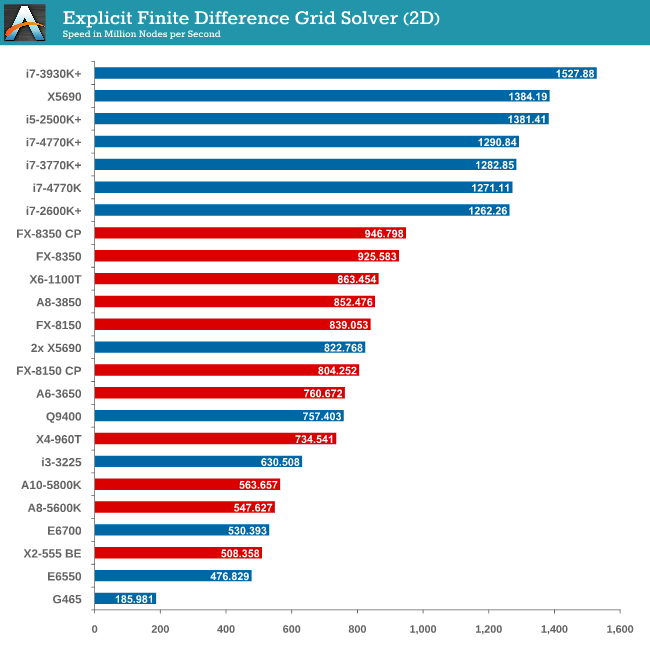
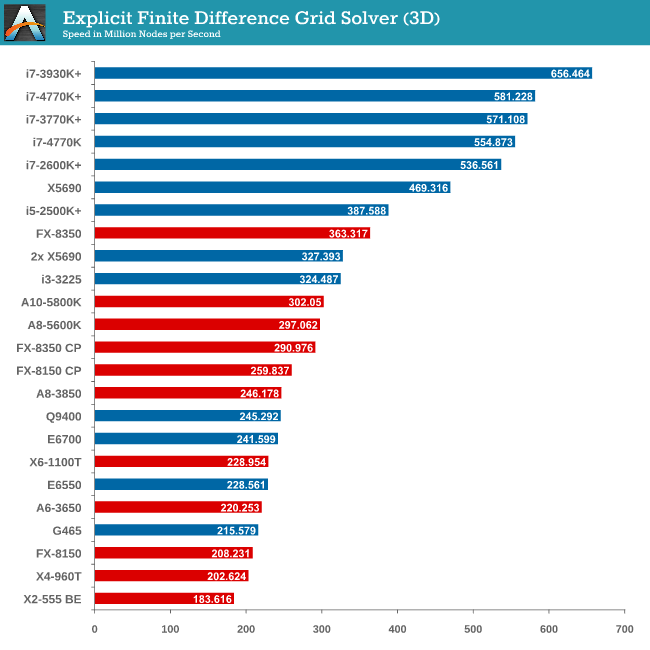
Grid Solvers - Explicit Finite Difference
For any grid of regular nodes, the simplest way to calculate the next time step is to use the values of those around it. This makes for easy mathematics and parallel simulation, as each node calculated is only dependent on the previous time step, not the nodes around it on the current calculated time step. By choosing a regular grid, we reduce the levels of memory access required for irregular grids. We test both 2D and 3D explicit finite difference simulations with 2n nodes in each dimension, using OpenMP as the threading operator in single precision. The grid is isotropic and the boundary conditions are sinks. Values are floating point, with memory cache sizes and speeds playing a part in the overall score.
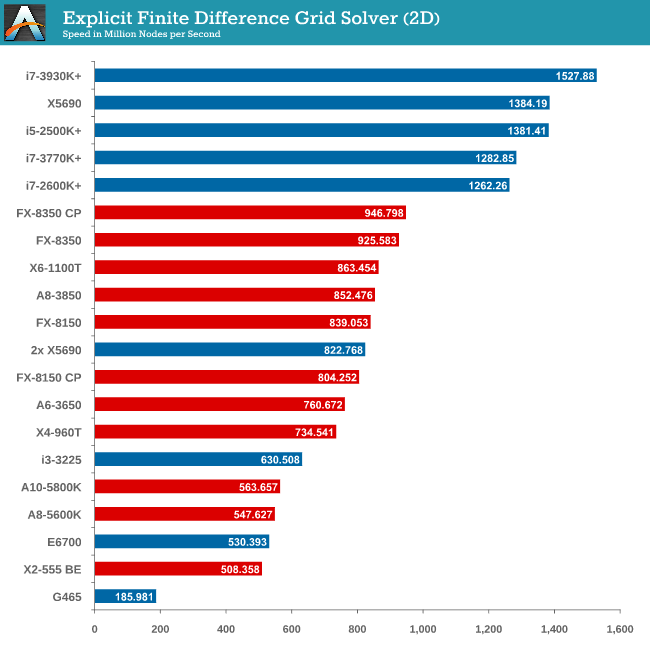
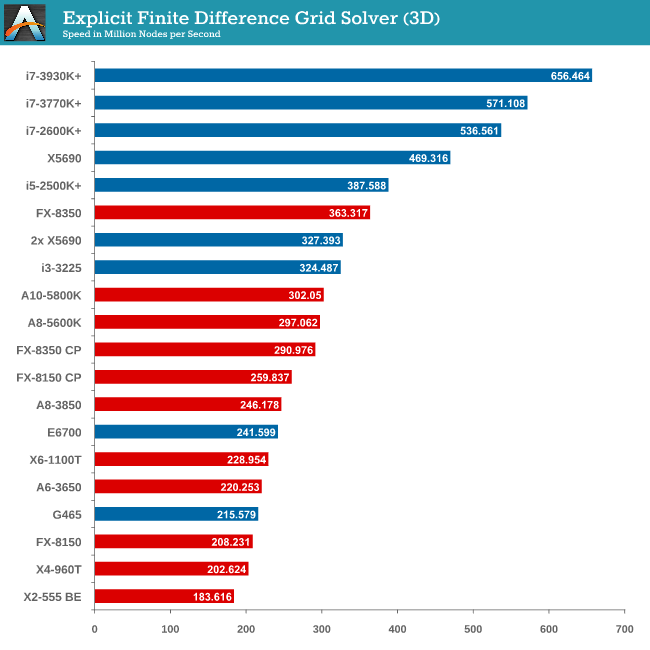
Grid solvers do love a fast processor and plenty of cache in order to store data. When moving up to 3D, it is harder to keep that data within the CPU and spending extra time coding in batches can help throughput. Our simulation takes a very naïve approach in code, using simple operations.
Grid Solvers - Implicit Finite Difference + Alternating Direction Implicit Method
The implicit method takes a different approach to the explicit method – instead of considering one unknown in the new time step to be calculated from known elements in the previous time step, we consider that an old point can influence several new points by way of simultaneous equations. This adds to the complexity of the simulation – the grid of nodes is solved as a series of rows and columns rather than points, reducing the parallel nature of the simulation by a dimension and drastically increasing the memory requirements of each thread. The upside, as noted above, is the less stringent stability rules related to time steps and grid spacing. For this we simulate a 2D grid of 2n nodes in each dimension, using OpenMP in single precision. Again our grid is isotropic with the boundaries acting as sinks. Values are floating point, with memory cache sizes and speeds playing a part in the overall score.
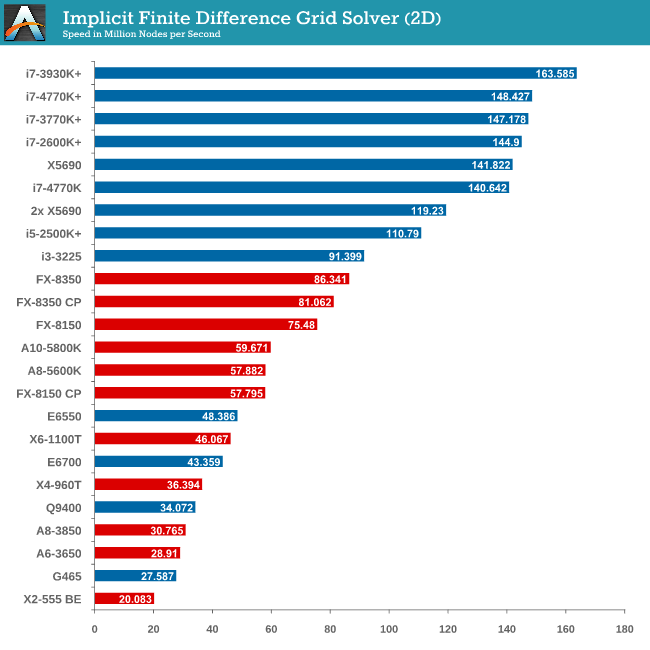
2D Implicit is harsher than an Explicit calculation – each thread needs more a lot memory, which only ever grows as the size of the simulation increases.
Point Calculations - n-Body Simulation
When a series of heavy mass elements are in space, they interact with each other through the force of gravity. Thus when a star cluster forms, the interaction of every large mass with every other large mass defines the speed at which these elements approach each other. When dealing with millions and billions of stars on such a large scale, the movement of each of these stars can be simulated through the physical theorems that describe the interactions. The benchmark detects whether the processor is SSE2 or SSE4 capable, and implements the relative code. We run a simulation of 10240 particles of equal mass - the output for this code is in terms of GFLOPs, and the result recorded was the peak GFLOPs value.
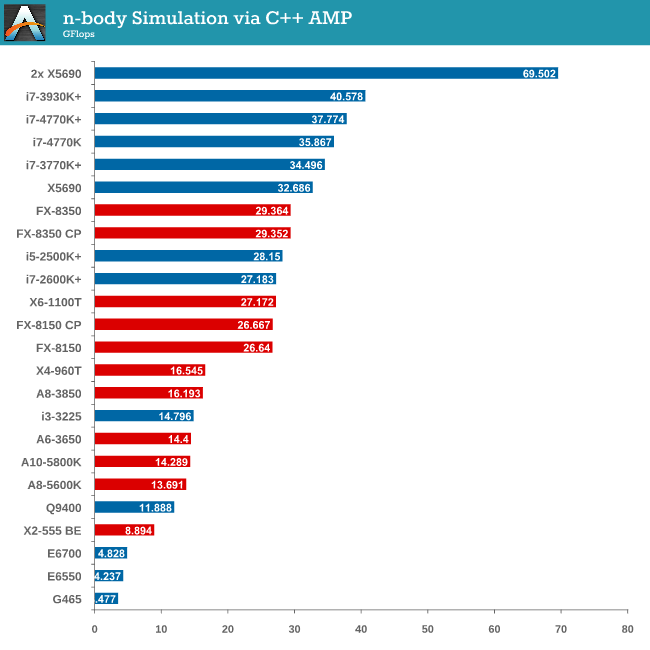
As we only look at base/SSE2/SSE4 depending on the processor (auto-detection), we don’t see full AVX numbers in terms of FLOPs.










116 Comments
View All Comments
TheJian - Wednesday, June 5, 2013 - link
So if you take out the 1920x1200 from the steam survey (4.16 - 2.91% right?), you've written an article for ~1.25% of the world. Thanks...I always like to read about the 1% which means absolutely nothing to me and well, 98.75% of the world.WHO CARES? As hardocp showed even a Titan still can't turn on EVERY detail at even 1920x1080. I would think your main audience is the 99% with under $1000 for a video card (or worse for multigpu) and another $600-900 for a decent 1440p monitor you don't have to EBAY from some dude in Korea.
Whatever...The midpoint to you is a decimal point of users (your res is .87%, meaning NOT ONE PERCENT & far less have above that so how is that midpoint? I thought you passed MATH)?...Quit wasting time on this crap and give us FCAT data like pcper etc (who seems to be able to get fcat results into EVERY video card release article they write).
"What we see is 30.73% of gamers running at 1080p, but 4.16% of gamers are above 1080p. If that applies to all of the 4.6 million gamers currently on steam, we are talking about ~200,000 individuals with setups bigger than 1080p playing games on Steam right now, who may or may not have to run at a lower resolution to get frame rates."
That really should read ~55,000 if you take away the 2.91% that run 1920x1200. And your gaming rig is 1080p because unless you have a titan (which still has problems turning it all on MAX according to hardocp etc to remain playable) you need TWO vid cards to pull off higher than 1920x1200 without turning off details constantly. If you wanted to game on your "Korean ebay special" you would (as if I'd ever give my CC# to some DUDE in a foreign country as Ryan suggested in the 660TI comment section to me, ugh). It's simply a plug change to game then a plug change back right? Too difficult for a Doctor I guess? ;)
This article needs to be written in 3 years maybe with 14nm gpus where we might be able to run a single gpu that can turn it all on max and play above 30fps while doing it and that will still be top rung, as I really doubt maxwell will do this, I'm sure they will still be turning stuff off or down to stay above 30fps min, just as Titan has to do it for 1080p now. Raise your hand if you think a $500 maxwell card will be 2x faster than titan.
1440p yields an overall pixel count of 3,686,400 pixels for a monitor in 1440p resolution, substantially higher than the 2,073,600 pixels found on a 1080p monitor/tv etc. So since Titan is SHORT of playing ALL games maxed on 1080p we would need ~2x the power at say $500 for it to be even called anywhere NEAR mainstream at 1440p right? I don't see NV's $500 range doing 2x Titan with maxwell and that is 6-9 months away (6 for AMD volcanic, ~7-9 for NV?). Raise your hand if you call $500 mainstream...I see no hands. They may do this at 14nm for $300 but this is a long ways off right and most call $200 mainstream right? Hence I say write this in another 3yrs when the 1080p number of users in the steam survey (~31%) is actually the 1440p#. Quit writing for .87% please and quit covering for AMD with FCAT excuses. We get new ones from this site with every gpu article. The drivers changed, some snafu that invalidated all our data, not useful for this article blah blah, while everyone else seems to be able to avoid all anandtech's issues with FCAT and produce FCAT after FCAT results. Odd you are the ONLY site AMD talked too directly (which even Hilbert at Guru3d mentions...rofl). Ok, correction. IT'S NOT ODD. AMD personal attention to website=no fcat results until prototype/driver issues are fixed....simple math.
http://www.alexa.com/siteinfo/anandtech.com#
Judging your 6 month traffic stats I'd say you'd better start writing REAL articles without slants before your traffic slides to nothing. How much more of a drop in traffic can you guys afford before you switch off the AMD love? Click the traffic stats tab. You have to be seeing this right Anand? Your traffic shows nearly in half since ~9 months ago and the 660TI stuff. :) I hope this site fixes it's direction before Volcanic & Maxwell articles. I might have to start a blog just to pick the results of those two apart along with very detailed history of the previous articles and comments sections on them. All in one spot for someone to take in at once I'm sure many would be able to do the math themselves and draw some startling conclusions about the last year on this site and how it's changed. I can't wait for Ryan's take on the 20nm chips :)
Laststop311 - Wednesday, June 5, 2013 - link
Who actually buys a computer and does nothing but game on it every second they are on it? That's why the A8-5600k should not be the recommended cpu. Just gonna drag you down in every other thing you do with the computer. The i5-2500k should be here too. You can get them for a STEAL on ebay used I've seen them go for around 140-150. Sure you can pay 100-110 on ebay for the a8-5600k is a 40 dollar savings worth that much performance loss?TheJian - Sunday, June 9, 2013 - link
I didn't even go into this aspect (it's not just about gaming as you say clearly). But thanks for making the other 1/2 of my argument for me :)Your statement plus mine makes this whole article & it's conclusions ridiculous. Most people buy a PC and keep it for over 3yrs, meaning you'll be punished for a LONG time every day in everything you do (gaming, ripping, rar, photos etc etc). AMD cpu's currently suck for anyone but very poor people. Even for the poor, I'd say save for another month or two as $50-100 changes the world for years for your computing no matter what you'll use it for. Or axe your vid card for now and by a higher end intel. Survive for a bit until you can afford a card to go into your machine. AMD just isn't worth it for now on desktops. I'm an AMD fan, but the computing experience on Intel today is just better all around if you ever intend on putting in a discrete card worth over say $100 and this comment only gets worse as gpu's improve leaving your cpu behind.
You will get more cpu limited every year. Also it's much easier to change gpu's vs cpu's (which usually requires a new board for substantial gains unless you really buy on the low-end). Having said that, buying low-end haswell today gets you a broadwell upgrade later which should yield some decent gains since it's 14nm. Intel is just hard to argue against currently and that is unfortunate for AMD since the bulk of their losses is CPU related and looks to just get worse (the gpu division actually made ~15mil or so, while cpu side lost 1.18B!). Richland changes nothing here, just keeps the same audience it already had for total losses. They need a WINNER to get out of losses. Consoles may slow the bleeding some, but won't fix the losses. Steamroller better be 30-40% faster (10-20% is not enough, it will again change nothing).
firefreak111 - Wednesday, June 5, 2013 - link
Quote: What we see is 30.73% of gamers running at 1080p, but 4.16% of gamers are above 1080p. If that applies to all of the 4.6 million gamers currently on steam, we are talking about ~200,000 individuals with setups bigger than 1080p playing games on Steam right now, who may or may not have to run at a lower resolution to get frame rates.Wrong. 2.91% is 1200p (1080p at a 16:10 ratio), which is barely higher resolution. 1.25% are truly above 1440p, a much smaller number. ~57 000 gamers compared to 1,380,000 gamers... I respect 1440p, getting a new system to play at that res, but the mainstream isn't any time soon.
I wish I could take this article seriously. You choose 4 games to recommend a CPU (Metro 2033, GPU Bound, Dirt 3, racing game focused on graphics, Civ V, which you knock off as unimportant based on FPS not turn times (which is all anyone really cares about in the late-game) and Sleeping Dogs, which is Open World but doesnt have complex scripting or AI.) and then choose AMD based on 3/4 of the games which are GPU bound and thus not favoring the faster Intel CPU's much?
FPS will only get you so far. Smoothness will be better on the faster CPU's. Anyway, most importantly, if you want to have a serious article with a good recommendation, how about testing CPU bound modern games? Shogun 2, mass AI calculations for many units combined with complex turn times (which is very important in any turn based game). Skyrim, with actually complex AI and large amounts of scripting, which uses the CPU to its utmost. Crysis 3, a good test for a balance of CPU and GPU focus. BF3 Multiplayer, which from personal experience needs a good CPU to play well.
Use Nvidia and AMD GPU's, one could favor the other leading to a better recommendation (This brand for this CPU). Civ V will see large performance gains on a Nvidia card combined with a good CPU, due to its use of deferred contexts (dx11 multithreading) and Nvidia's support of it (AMD seriously needs to step up and support it, most game engines aren't because AMD isn't. Its built into DX11, so support it AMD!).
Lastly, recommend for the mainstream. 1080p is the mainstream. Not 1440p+, which is 1.25% of steam players, 1080, which is more than 30%.
CiccioB - Wednesday, June 5, 2013 - link
I wonder what's the meaning of conducting such a big effort like this to test CPU performances and then making all the systems GPU bottlenecked just to take into consideration 4% of the gaming population.Moreover, some test done with an "old" GTX580 which bottlenecks in those resolution quite soon.
I renew my request of updating the list of games used and using most "popular" video settings in order to make a real comparison of what a gamer may find using the usual setup it may use at home. Monitor bigger than 24" are not popular at all.
Maybe an integration with a SLI/Tri SLI setup and a 5800x resolution may be added, but surely that should not be considered the way things work normally and taken a sdefinitive benchmark results to get some obviously confusing conclusions.
An A10-xxxx is way way behind any i5 CPU, and often even behind some i3 in realgaming. I can't really understand how one can believe in such a suggestion.
I am starting to think that something else rather than objective results are being created and shown here.
TheJian - Sunday, June 9, 2013 - link
AMD only visited ONE website in recent history. ANANDTECH.Also note they pushed this 1440p idea when the numbers were EVEN WORSE in the 660TI article comments section (and even the articles conclusions, we're talking 9 months ago - 1440p is STILL not popular nor above it). See Ryan's exchange in that article with me. He was pushing the Korean Ebay dude then...ROFL. I pointed out then that amazon only had 2 people selling them and they had no reviews (ONE, which was likely the guy that owned the place selling it), no support page, no phone, and their website wasn't even their own domain and email was a gmail address if memory serves. Essentially giving your CC# to some dude in Korea and praying. Which another site mentioned he did pray when ordering a test unit...LOL Techreport's 1440p korean review back then if memory serves. Yet Ryan claimed everyone in the forums was doing this...Whatever... Don't even get me started on Jared's personal attack while ignoring my copious amounts of data proving Ryan's article BS even with using Ryan's own previous article's benchmarks! It's kind of hard to argue against your own data right?
I sincerely hope this site goes back to producing articles on cpu/gpu that are worthy of reading. These days all they do is hide AMD's inadequacies vs. Intel and NV. They are the only site saying things like "buy an A8-5600 for any SINGLE gpu machines"...I can't believe how far they've gone in the last 9 months. Their traffic stats show I'm not alone. The comments here show I'm not alone. AMD can't be paying them enough to throw their whole reputation down the drain. Look what the Sysmark/Bapco/Van Smith scandal did to Tomshardware (Tom even changed all his bylines to "tom's staff" or some crap like that). He had to sell at far less than the site was worth before the damage, and it took years to get back to a better reputation and wash off the stink. Heck I stopped reading in disgust for years and many IT friends did the same. I mean they were running Intel ads in AMD review articles...LOL. I think that is just wrong (the van smith stuff was just unconscionable). For those who remember Van, he still writes occasionally at brightsideofnews.com (I only recently discovered this, also writes on vanshardware but not much analysis stuff). Good to see that.
Pjotr - Wednesday, June 5, 2013 - link
What happened to the Q9400 in the GPU charts, it's missing? No, I didn't read the full article.HappyHubris - Wednesday, June 5, 2013 - link
I know this was addressed in the article, but no 2013 gaming part recommendation should be published based on average FPS.Any Ivy Bridge i3 mops the floor with a 5800K, and I'd imagine that Sandy-based i3s would do so even cheaper. http://techreport.com/review/23662/amd-a10-5800k-a...
Kudos on an article that includes older processors, though...it's nice to see more than 1 or 2 generations in a review.
ArXiv76 - Wednesday, June 5, 2013 - link
Having read technical articles, white papers and tech reviews for over 25 years I can't remember ever reading a "finding perfection" examination. My hypothesis is, does there exist a CPU(all CPU's tested) to GPU(all OEM's tested) mix that is ideal. Obviously speed is king so I am thinking more from an engineering perspective.Does this exist?
Steam and EA online are both great services. If there is a service that takes away physical media it's a huge winner to me. I still have my piles Sierra game boxes stored away.
bigdisk - Wednesday, June 5, 2013 - link
Oh, Anand / Ian CutressYou really shouldn't put your benchmark title and settings within an image. You absolutely want this as text in the page for SEO.
Cheers, good article.